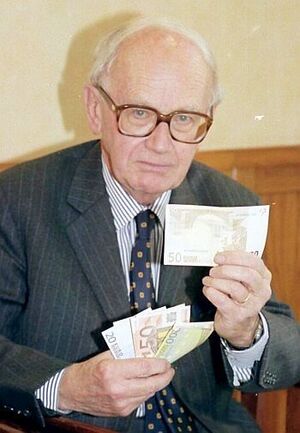Alexandre Lamfalussy
( Economist, central banker) | ||||||||||||||||||||||||||||||
|---|---|---|---|---|---|---|---|---|---|---|---|---|---|---|---|---|---|---|---|---|---|---|---|---|---|---|---|---|---|---|
 | ||||||||||||||||||||||||||||||
| Born | 26 April 1929 Kapuvár, Hungary | |||||||||||||||||||||||||||||
| Died | 9 May 2015 (Age 86) Ottignies, Belgium | |||||||||||||||||||||||||||||
| Nationality | Belgian (Born: Hungarian) | |||||||||||||||||||||||||||||
| Alma mater | • Catholic University of Leuven • Nuffield College Oxford | |||||||||||||||||||||||||||||
| Member of | Delors committee, Group of Thirty | |||||||||||||||||||||||||||||
BIS manager, First President of the European Monetary Institute, 4 Bilderbergs
| ||||||||||||||||||||||||||||||
Baron Alexandre Lamfalussy was a Hungarian-born Belgian economist and central banker who worked for the Bank for International Settlements and was the first President of the European Monetary Institute. He attended the Bilderberg in 1983, 1986, 1988 and 1992.
Background
Born in Kapuvár, Hungary,[1] Lamfalussy left his native country in 1949. Accepted as a political refugee in Belgium (he obtained Belgian nationality in 1962), he enrolled in the second year of economics at the Catholic University of Leuven] in September 1949.[2] He graduated in economics in 1952. At the Institute of Economics, he met four professors who would influence him, namely Léon Dupriez, Paul Rousseaux, Michel Woitrin and Yves Urbain. He then undertook postgraduate studies at Nuffield College, Oxford (1953-1954) and obtained a doctorate in economics at Oxford in 1957. He later taught at the University of Louvain (UCLouvain) and Yale.
Banking
He began his career at Banque de Bruxelles (now part of the ING Group) in 1955 as an economist. He then became an economic adviser, then was executive director between 1965 and 1975. He was chairman of its Management Committee from 1972; in this capacity, he took part in the merger between Banque de Bruxelles and Banque Lambert, which in 1975 gave birth to Banque Bruxelles Lambert.[3]
Lamfalussy participated in many study groups and was a member of various bodies including, in particular, his participation in the Bellagio Group, an international study group bringing together 32 economists between 1963 and 1964. In 1963 he was among the founders of SUERF – an association originally set up as a group to promote financial research among academics, and was the Association's first Honorary Treasurer. In honour of his contribution to European monetary and financial issues, he was made an honorary member of SUERF at the association's 40th anniversary meeting held at the Banque de France in Paris.
From 1976 he was an economic adviser to the Bank for International Settlements in Basel and held the post of assistant general manager from 1981 to 1985. He was then general director of the bank, where he remained until 1993.
From 1994 to 1997 he was founding president of the European Monetary Institute in Frankfurt, forerunner to the European Central Bank.
From 2000 to 2001 he chaired the Committee of Wise Men on the Regulation of European Securities Markets, whose proposals were adopted by the Council of the European Union in March 2001. As chair of the committee, he oversaw the creation of the Lamfalussy process, an approach to the development of financial service industry regulation used most famously in MiFID - the Markets in Financial Instruments Directive. In 2013 he was decorated with Hungary's highest decoration, the Hungarian Order of Saint Stephen. He died on 9 May 2015 in Ottignies, Belgium.[4]
Events Participated in
| Event | Start | End | Location(s) | Description |
|---|---|---|---|---|
| Bilderberg/1983 | 13 May 1983 | 15 May 1983 | Canada Quebec Château Montebello | The 31st Bilderberg, held in Canada |
| Bilderberg/1986 | 25 April 1986 | 27 April 1986 | Scotland Gleneagles Hotel | The 34th Bilderberg, 109 participants |
| Bilderberg/1988 | 3 June 1988 | 5 June 1988 | Austria Interalpen-Hotel Telfs-Buchen | The 36th meeting, 114 participants |
| Bilderberg/1992 | 21 May 1992 | 24 May 1992 | France Royal Club Evian Evian-les-Bains | The 40th Bilderberg. It had 121 participants. |
References
- ↑ https://books.google.com/books?id=s90MD22wtA4C&q=%22Lamfalussy,+Alexandre%22+1929
- ↑ Lamfalussy Christophe, Maes Ivo, Péters Sabine, Alexandre Lamfalussy. Le sage de l’euro, Racine, Bruxelles, 2013, p. 41 et 45.
- ↑ Jean-Pierre Stroobants, « Alexandre Lamfalussy, l’un des pères de l’euro, est mort » archived.
- ↑ https://www.thetimes.co.uk/
Wikipedia is not affiliated with Wikispooks. Original page source here